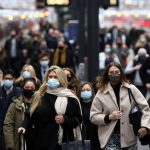A wave of Omicron cases is possible over the summer as people resume social activities and the effect of the vaccines wanes, according to scientists advising the government.
Experts from the Scientific Advisory Group for Emergencies (Sage) said the precise timing and magnitude of the “exit wave” is “highly dependent on both population behaviour and the scale of the current wave, and cannot be predicted with any certainty”.
According to modelling, the projection is for between fewer than 1,000 admissions each day in the next wave to about 2,000 each day, if plan B restrictions remain in place until the end of January and are followed by a gradual return to socialising.
Latest COVID updates from the UK and around the world
Omicron has shown itself to be a milder form of COVID-19, with those admitted to hospital less likely to need oxygen and less likely to require intensive care, early data suggests.
Instead, there have generally been better outcomes and shorter stays for patients, and one analysis showed a reduction in risk of hospitalisation of between 35% and 65% for Omicron when compared with Delta.
The growth advantage of Omicron over Delta may also have been over-estimated, the documents suggest, due to Omicron having a shorter generation time (the average time between a person getting infected and then infecting others).
COVID-19: England’s R number now stands at between 1.1 and 1.5 as UK case numbers fall again
Boris Johnson: Downing Street apologises to the Queen for Number 10 lockdown parties held on eve of Prince Philip’s funeral
COVID-19: Face masks make people look more attractive, study suggests
But that does not mean everyone can relax, as hospital admissions are expected to peak later this month, according to the group.
The group said: “It remains likely based on the scenarios that hospital admissions in England will remain high for some time as a result of the very high number of infections and the continued risk of hospitalisation for the elderly and unvaccinated adults in particular.”
On Friday, the UK Health Security Agency updated England’s COVID R number to between 1.1 and 1.5 – a slightly wider range than last week’s estimate of 1.2 to 1.5.
This means that every 10 people infected with coronavirus will on average pass the disease to between 11 and 15 other people.
The UK reported 99,652 new cases on Friday – down from 109,133 on Thursday. This means that the seven-day tally fell by 29.5% compared to the previous week.
On Tuesday, rules came into force meaning that people in England who get a positive result from a lateral flow test will no longer need a follow-up PCR to begin their isolation period if they do not have symptoms.
There were 270 deaths reported in the same 24-hour period to Friday – down from 335 deaths reported on Thursday and 398 deaths reported on Wednesday.
Friday’s figures showed that the seven-day total for deaths was up 67% on the previous week.
This brings the total number of COVID-related deaths to more than 151,000.
However, separate figures published by the Office for National Statistics show there have been more than 174,000 deaths registered in the UK where COVID-19 was mentioned on the death certificate.






















